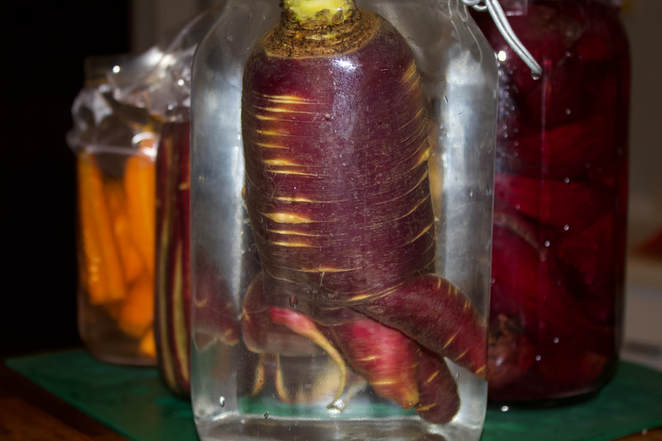fermented foods
Kimchi. Sauerkraut. Kefir. Tempeh. Yogurt.
What do these foods all have in common? They are fermented foods that may promote good gut health and weight loss, improve immunity and even allergies. In it's most basic sense, As Sandor Katz explains, "Fermentation is the transformation of food by various bacteria, fungi, and the enzymes they produce." Katz is the expert if you didn't know - He's the author of The Art of Fermentation, and should be on every food enthusiasts bookshelves. It's more informative than recipe-based, designed to introduce and educate one on the variety of fermented foods and beverages. Coupling Katz with Rene Redzepi and David Zilber's new book, The Noma Guide to Fermentation, will set you up to make a plethora of delicious, nutritious, fermented foods. In Redzepi's book, there's even a how-to guide on building an incubation chamber. I'm still putting together the supplies so that I can make koji. How nerdy is that? Ha! Watch the video below to learn more about koji:
Koji aside, many fermentations do not require you to create or purchase your very own chamber to ferment at home. In fact, you can make the most basic recipes with just about any vegetable -some fruits too- without any special equipment: All you need is a vessel, scale, salt, and the produce of your choice. Simple.
And there's no need to be afraid of getting started for fear of the wrong bacteria growing: Any microbiologist will tell you that "risky" is not a word used to describe the process of a simple vegetable fermentation. The lactic acid bacteria that is found on all plants develops quite quickly when fermenting, and can out-compete the incidental pathogenic bacteria. Fear not: When you preserve in brine, things like botulism need not be of concern. Here's how it works: When a plant is harvested, it contains many microorganisms that continue to multiply and diversify. Aerobic bacteria get replaced by anaerobes, which includes many different types of lactic acid bacteria. After the plant becomes submerged, fermentation then begins. Carbon dioxide, alcohol, and acetic acid are also produced. Enough with the science, let's get to the kitchen and ferment something. fermentation: getting started
Fermenting foods and beverages is not something new. It's been around for centuries, playing an instrumental role in human evolution.
Fermentation can be summed up with four words: "chop, salt, pack, wait." (Katz).
*salt* means the amount salt = 2% of the total weight of vegetable and liquid. As you can see from my pictures above, I chose the brine method. Next time, I'll try grating my vegetables. The objective is to expose as much surface area as possible to pull out the juice from within the vegetable. Clearly, if you take a look at the picture, I couldn't help but ferment the carrot in it's original shape, so I kept it whole. Yes, it will take longer to ferment, but the shape was too gnarly to mess with... The beets were sliced into small quarters, and the remaining carrots were cut into large matchsticks. My advice? Keep it simple the first go around. Taste what happens to the food every few days, and when you think it has reached its ideal taste, refrigerate. You can always make another batch and play with spice and aromatics to add to the flavor. The point is to get you in your kitchen cooking and experimenting. The verdict is still out on all the positive health benefits of fermented foods, but it's certainly a hot topic in the nutrition world, and it continues to be studied. If you live in Minneapolis/St. Paul, MN, you too could participate in a gut study involving fermented vegetables. Simply contact Ky from GYST Fermentation Bar to learn more about how to join. Looking for more inspiration? Check out my Mac 'n' Chi post for more a different way to play with home fermentations.
1 Comment
3/29/2022 10:09:07 am
My favorite part of this article is when you said that they are fermented foods that may encourage good gut health and loss of weight, enhance immunity, and even allergies. My high school teacher approached me today and ask if I have any idea of any Lactic acid supplier for his new food processing business. I will share this post for her to have an idea of where to find lactic acid.
Reply
Leave a Reply. |
SEARCH ARTICLES BY CATEGORYAll Dough & Noodle Main Nosh Sauce Or Spread Skin Soups & Stews Spices Sweets READ NEXTMOST POPULAR |
Copyright © 2015 Ranelle Kirchner - All Rights Reserved - Designed by Adrian Daniel Schramm

